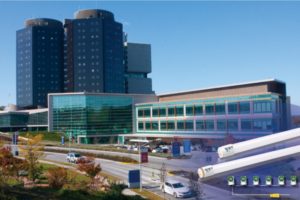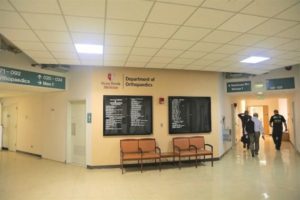In New York State, Stony Brook University Upgrades To LED Lighting
February 15, 2022 | Press Releases
As part of the state’s BuildSmartNY energy efficiency program, the university upgraded its entire medical campus with Starco Lighting products.
The State University of New York (SUNY) is the largest comprehensive system of universities, colleges, and community colleges in the U.S. with a total enrollment of 424,051 students, plus 2,195,082 adult education students, spanning 64 campuses across the state. SUNY includes many institutions and four university Centers — Albany, Binghamton, Buffalo, and Stony Brook.
Stony Brook is a public sea-grant and space-grant research university in Stony Brook, NY, about 60 miles east of New York City on Long Island. The university is comprised of approximately 220 major buildings with a combined area of more than 12.2 million gross square feet across 1,454 acres of land on the North Shore of Long Island. Stony Brook is the largest single-site employer on Long Island. More than 26,000 students are enrolled at the university, which has over 15,000 employees and greater than 2,700 faculty.

Stony Brook University took part in BuildSmart NY, a program designed to aggressively pursue energy efficiency in all state government buildings. In 2012, when then-Governor Andrew M. Cuomo signed Executive Order No. 88, it mandated a 20% improvement in energy efficiency performance in all state government-owned buildings by April 2020, based on 2011 fiscal year levels. The Executive Order designated the New York Power Authority (NYPA), the country’s largest state public power organization, to coordinate compliance.
As a turnkey partner, NYPA provided audit, design, procurement, construction management and closeout to an energy improvement project at Stony Brook — which focused on its entire medical campus. Palwinder Singh, EIT, CEM, PMP, is the project engineer assigned to SUNY-Stony Brook. As the project manager, his role is to ensure timely completion of the project scope with minimal disruptions to facility operations and occupants. He’s responsible for all aspects of the project schedule and budget.
Pres Energy of Getzville, NY is the Engineer of Record, and Candela Systems Corp. of Hawthorne, NY was the lowest qualified bidder on the LED lighting upgrades. Both companies have a contract with the NYPA. Pres Energy was involved with the design and development where Candela implemented the scope of work.
Medical Campus Lighting Focus Of Work
The Stony Brook medical campus consists of five major buildings totaling about 2.1 million square feet. The 19-story University Medical Center is the largest building and includes the hospital administration, patient rooms, operating rooms, the cafeteria, and doctors’ offices. The Health Sciences Center is a two-story building and includes classrooms, laboratory, library, and faculty offices. The Basic Science Tower is a nine-story building which holds classrooms, labs, and offices. The Ambulatory Care Pavilion (ACP) covers two stories and includes a cancer care clinic, cancer test labs, and doctors’ offices. The Ambulatory Surgery Center (ASC) is a single-story holding eight operating rooms, patient beds and doctors’ offices.

Since the facilities operate around the clock, seven days a week, the lighting retrofit took place during off hours as contractors needed to work around personnel and had limited access to rooms. But in 2019, they replaced the fluorescent T8 lamps with linear LED Lamps from Starco Lighting, headquartered in Buffalo, NY. Workers were faced with ceiling heights from 8- to 40-feet as they performed the lighting retrofit which included the replacement of 2, 3, 4 and 8-foot fluorescent tubes. The changeout was 1-for-1.
Starco’s LED lamps are warrantied for eight years — a significant warranty for LED lamps on the market. The 10% lumen depreciation mark of their LED lamps has risen from 60k hours, at the time, to over 90k hours. For operations running around the clock, this feature was very important. Designers and engineers upgrade lighting to LED with only 10% clearance above the minimum specification. Most LED lamps on the market depreciate by 10% every 26k hours. For a 24/7 operation, this means the lighting will fall below specification before the 3-year mark. With Starco’s LED lamps, the equation changes to 10 years, or well over the 8-year warranty.

The project also consisted of using Starco’s Fused wiring kits. These kits enable a faster installation and mitigate any other electrical risk that upgrading the wiring for the fixtures might have posed. These kits come in a variety of combinations including with 1 socket, 2, 3, 4, and 6 and come with different colors to distinguish lamps that are on an emergency line. Starco’s Fused wiring kits consist of G13 lamp-holders made by AAG Stucchi, an Italian lamp-holder manufacturer. The 3000-series lamps-holders were redesigned in 2014 to handle direct line voltage up to 277V, conductor to conductor. This is not to be confused with the typical rating listed on a lamp-holder of 300V or 600V, which indicates the maximum voltage from conductor to ground. That is not the rating between the contacts inside the lamp-holders themselves. The redesign included increasing the minimum creepage distance between contacts of the lamp-holder and increasing the limit of insulating resistance between contacts of the lamp-holder from ½ MΩ to 2MΩ. There is no other lamp-holder manufacturer that has come out and stated that they’ve done this. In fact, a few lamp-holder manufacturers, have come out and stated that they do not authorize the usage of their G13 lamp-holders with direct line voltage LED tubes.
Some of the other metrics that resulted in the specification of the lamps included the lumen output, efficiency, glare, robustness, safety, and reliability. Starco Lighting produces LED high bays, linear lights, industrial/commercial LED tubes, and a series of horticulture lighting. The company’s philosophy is to create products that are strong enough for industrial but economical enough for commercial applications. This philosophy stems from their close relationships with their national customers around the country — design products with the end-user in mind and not just another commodity to traverse the national supply chains. Due to these qualities and more, Starco’s retrofit solutions were specified for the Stony Brook Medical Campus project.
Stony Brook pays approximately 11.3 cents per kilowatt hour. The project to upgrade the fluorescent lighting included the replacement of about 38,000 lamps or the upgrade of about 19,000 fixtures. With the tube replacement portion of the project costing roughly $2 million and the operation of the lighting being around the clock, the simple payback was about three years not including any maintenance savings. Stony Brook University is saving about $700k in energy savings annually and will look to enjoy those savings and the improvement of lighting for about a decade. The cost of retrofitting the fixtures was a fraction of the cost of replacing the fixtures while still realizing 80-90% of the energy savings. In addition, the campus can elect to replace with more energy efficient tubes in 10 years with no rewiring or electrical work needed as all of the components are integral to the tube. This ensures that they have a sustainable way of realizing even more energy savings in the future without having to go through another intrusive and costly installation.
Other News & Updates
Starco SLGL Tunable Grow Light with Add-on Boosters Wins LEDs Magazine Brightstar Award
June 24, 2022 | Press Releases
Starco SLGL Tunable Grow Light with Add-on Boosters Wins LEDs Magazine Brightstar Award Starco Lighting is pleased to announce the SLGL Tunable Grow Light with Add-on Bossters wins 2022 BrightStar Awards. The Endeavor Business Media brand launched this year to recognize ingenuity in commercial components, materials, tools, […]

Nestlé Sweet On LED
May 3, 2021 | Press Releases, Technology
Nestlé Purina’s manufacturing facility in Dunkirk, NY, recently received an LED lighting upgrade funded by a $125,000 National Grid energy efficiency incentive. by IES on April 20, 2021 in LDA Online Nestlé Purina’s manufacturing facility in Dunkirk, NY, recently received an LED lighting upgrade funded by a $125,000 […]